Abstract
Glucokinase and phosphoenolpyruvate carboxykinase are key enzymes of glucose metabolism in the rat liver. The former is considered to be instrumental in regulating glucose hepatic release/uptake according to the glycaemia level, and cytosolic phosphoenolpyruvate carboxykinase is a major flux-generating enzyme for gluconeogenesis. The level of expression of both enzymes and the regulation of their mRNAs in the human liver cell were investigated. Surgical biopsies of liver from patients undergoing partial hepatectomies and parenchymal hepatocytes derived from the biopsies were used to assay glucokinase, hexokinase and phosphoenolpyruvate carboxykinase activities. Hepatocytes were placed in culture and the actions of insulin, glucagon and cAMP on glucokinase and phosphoenolpyruvate carboxykinase mRNAs were studied. The main results are: (a) glucokinase accounts for 95% of the glucose phosphorylation activity of human hepatocytes, although this fact is masked in assays of total liver tissue; (b) glucokinase activity is set at a lower level in human hepatocytes than in rat hepatocytes, and vice-versa for the gluconeogenic enzyme phosphoenolpyruvate carboxykinase; and (c) as previously shown in rat liver, glucokinase and phosphoenolpyruvate carboxykinase mRNAs are regulated in a reciprocal fashion in human hepatocytes, insulin inducing the first enzyme and repressing the latter, whereas glucagon has opposite effects. These data have interesting implications with respect to metabolic regulation and intracellular hormone signaling in the human liver.
Full text
PDF
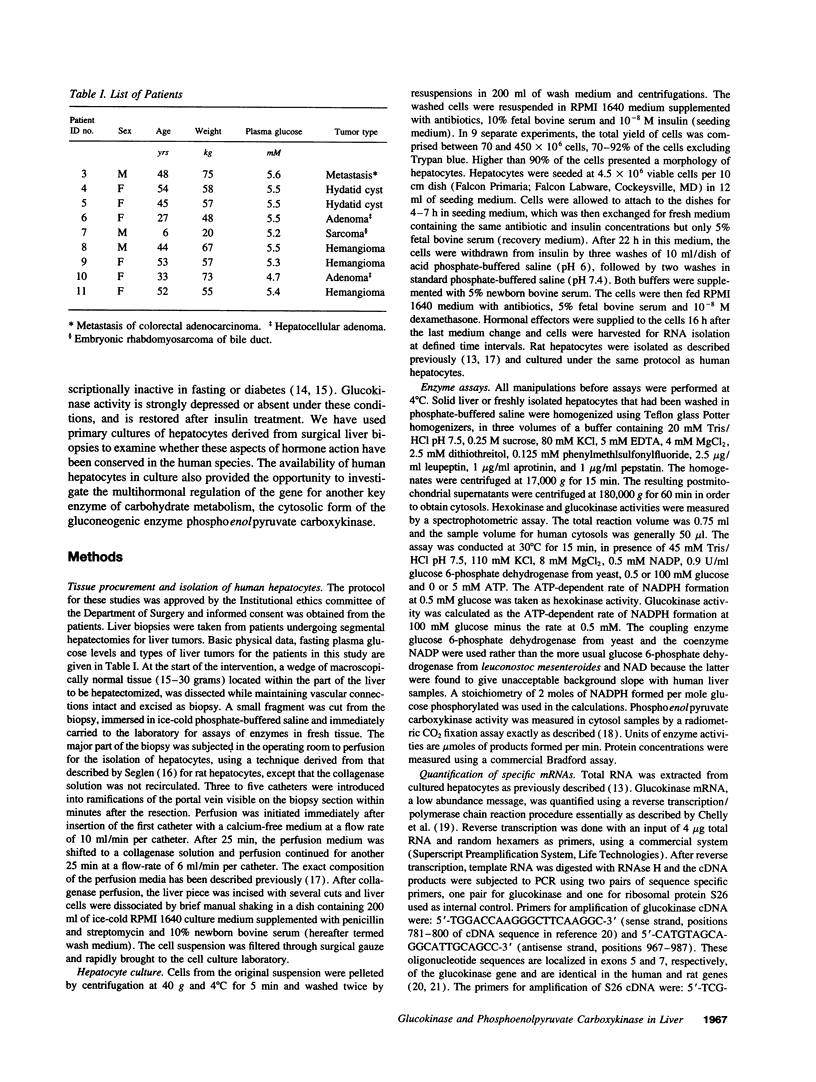

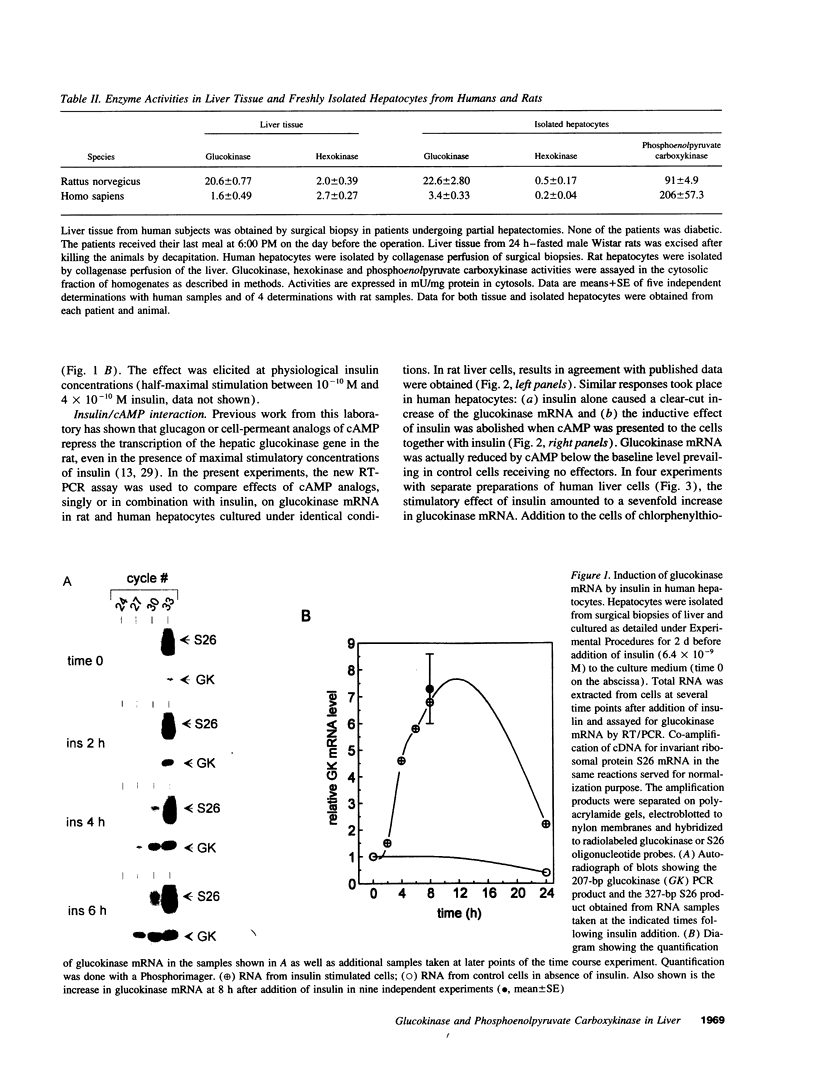
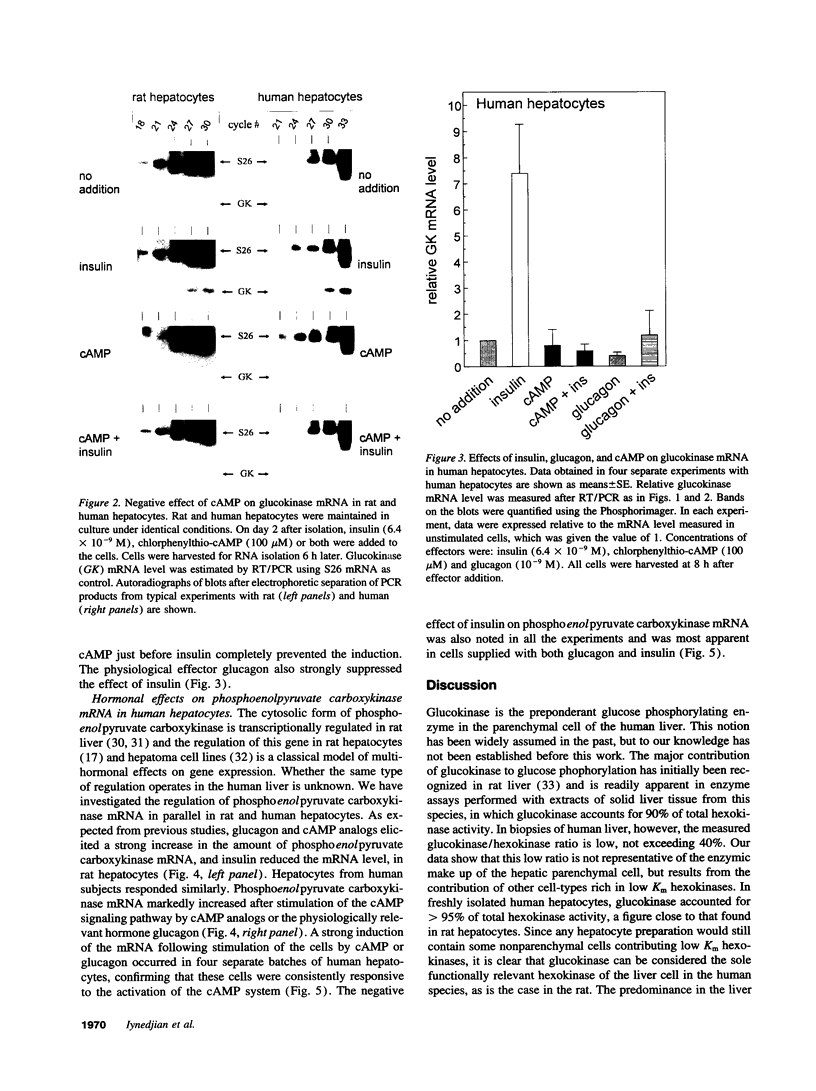
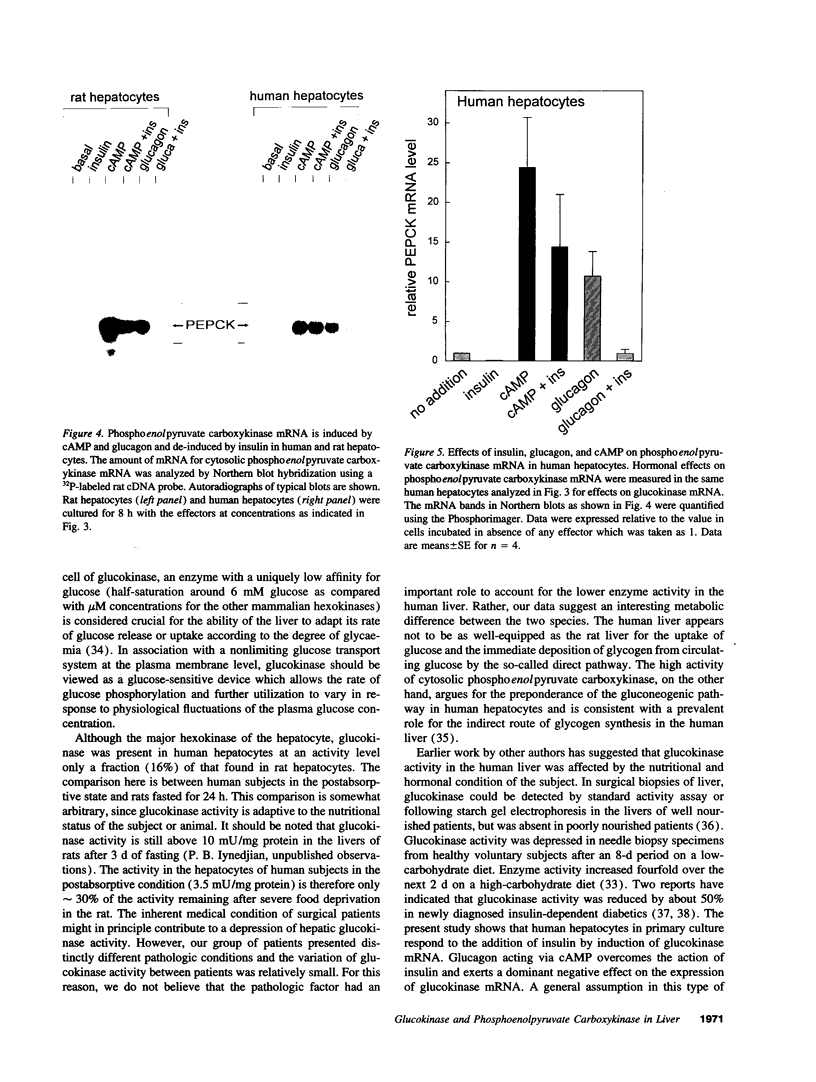
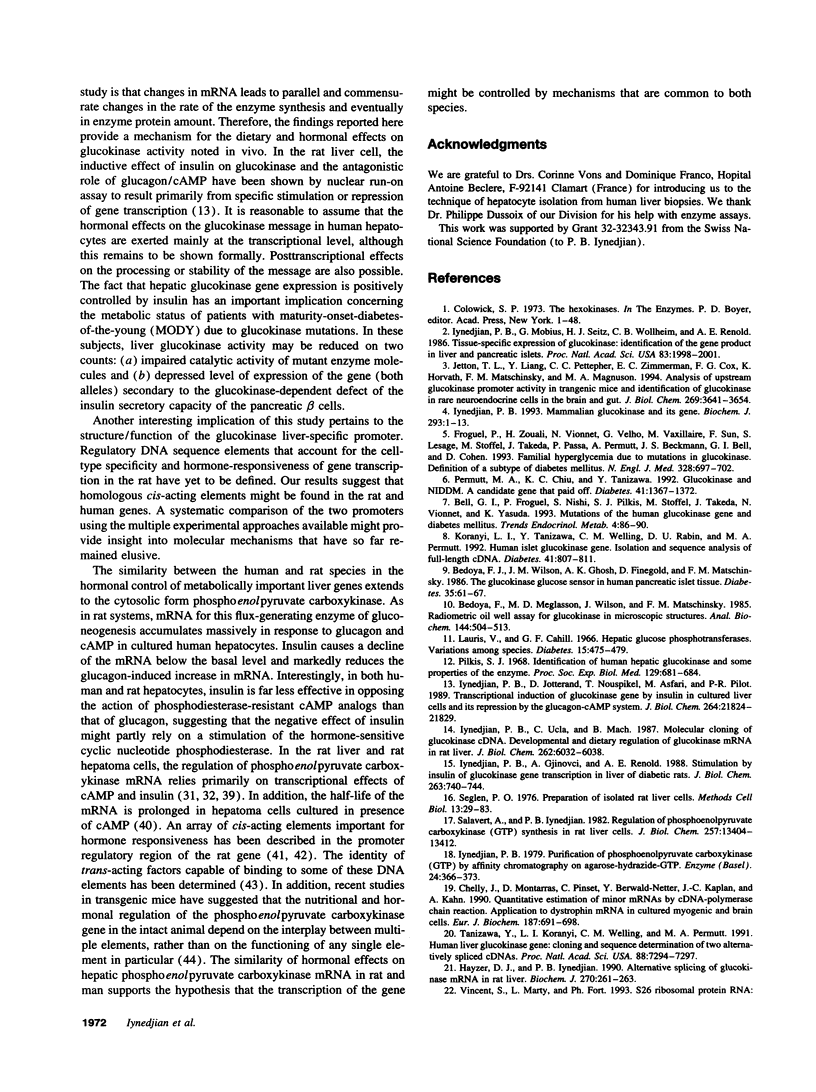
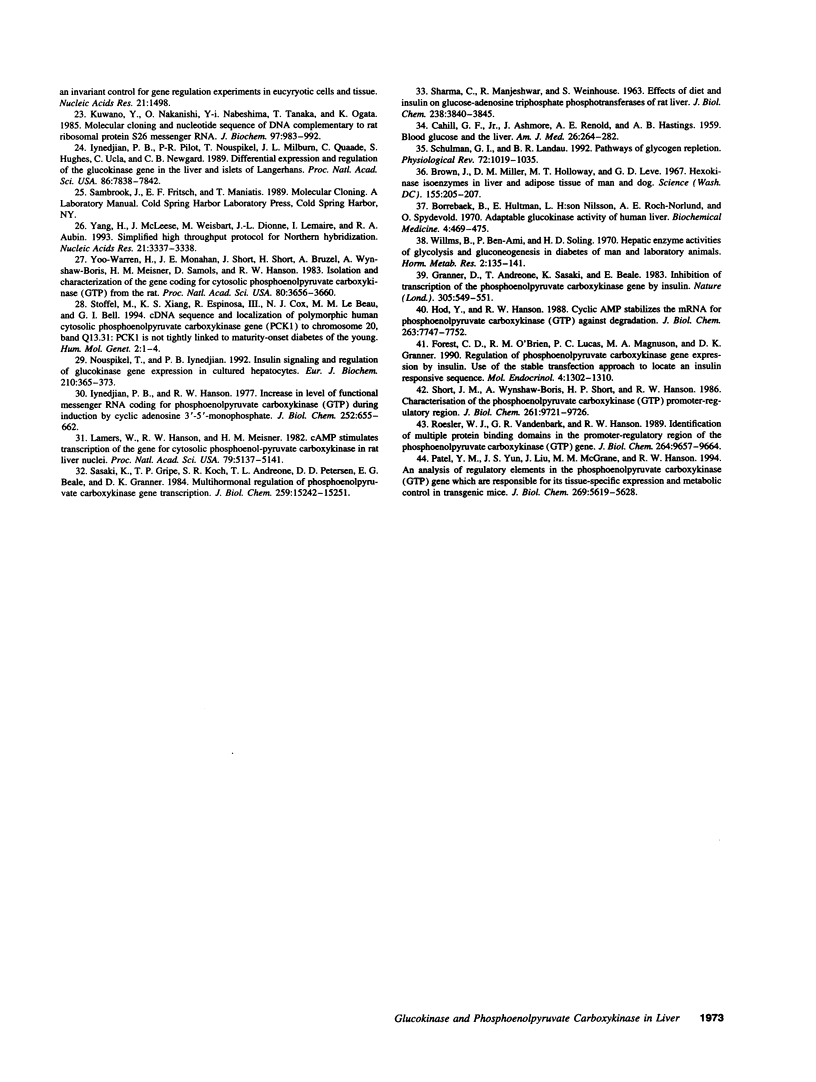
Images in this article
Selected References
These references are in PubMed. This may not be the complete list of references from this article.
- Bedoya F. J., Meglasson M. D., Wilson J. M., Matschinsky F. M. Radiometric oil well assay for glucokinase in microscopic structures. Anal Biochem. 1985 Feb 1;144(2):504–513. doi: 10.1016/0003-2697(85)90147-2. [DOI] [PubMed] [Google Scholar]
- Bedoya F. J., Wilson J. M., Ghosh A. K., Finegold D., Matschinsky F. M. The glucokinase glucose sensor in human pancreatic islet tissue. Diabetes. 1986 Jan;35(1):61–67. doi: 10.2337/diab.35.1.61. [DOI] [PubMed] [Google Scholar]
- Borrebaek B., Hultman E., Nilsson L. H., Roch-Norlund A. E., Spydevold O. Adaptable glucokinase activity of human liver. Biochem Med. 1970 Dec;4(5):469–475. doi: 10.1016/0006-2944(70)90076-1. [DOI] [PubMed] [Google Scholar]
- Brown J., Miller D. M., Holloway M. T., Leve G. D. Hexokinase isoenzymes in liver and adipose tissue of man and dog. Science. 1967 Jan 13;155(3759):205–207. doi: 10.1126/science.155.3759.205. [DOI] [PubMed] [Google Scholar]
- CAHILL G. F., Jr, ASHMORE J., RENOLD A. E., HASTINGS A. B. Blood glucose and the liver. Am J Med. 1959 Feb;26(2):264–282. doi: 10.1016/0002-9343(59)90316-x. [DOI] [PubMed] [Google Scholar]
- Chelly J., Montarras D., Pinset C., Berwald-Netter Y., Kaplan J. C., Kahn A. Quantitative estimation of minor mRNAs by cDNA-polymerase chain reaction. Application to dystrophin mRNA in cultured myogenic and brain cells. Eur J Biochem. 1990 Feb 14;187(3):691–698. doi: 10.1111/j.1432-1033.1990.tb15355.x. [DOI] [PubMed] [Google Scholar]
- Forest C. D., O'Brien R. M., Lucas P. C., Magnuson M. A., Granner D. K. Regulation of phosphoenolpyruvate carboxykinase gene expression by insulin. Use of the stable transfection approach to locate an insulin responsive sequence. Mol Endocrinol. 1990 Sep;4(9):1302–1310. doi: 10.1210/mend-4-9-1302. [DOI] [PubMed] [Google Scholar]
- Froguel P., Zouali H., Vionnet N., Velho G., Vaxillaire M., Sun F., Lesage S., Stoffel M., Takeda J., Passa P. Familial hyperglycemia due to mutations in glucokinase. Definition of a subtype of diabetes mellitus. N Engl J Med. 1993 Mar 11;328(10):697–702. doi: 10.1056/NEJM199303113281005. [DOI] [PubMed] [Google Scholar]
- Granner D., Andreone T., Sasaki K., Beale E. Inhibition of transcription of the phosphoenolpyruvate carboxykinase gene by insulin. Nature. 1983 Oct 6;305(5934):549–551. doi: 10.1038/305549a0. [DOI] [PubMed] [Google Scholar]
- Hayzer D. J., Iynedjian P. B. Alternative splicing of glucokinase mRNA in rat liver. Biochem J. 1990 Aug 15;270(1):261–263. doi: 10.1042/bj2700261. [DOI] [PMC free article] [PubMed] [Google Scholar]
- Hod Y., Hanson R. W. Cyclic AMP stabilizes the mRNA for phosphoenolpyruvate carboxykinase (GTP) against degradation. J Biol Chem. 1988 Jun 5;263(16):7747–7752. [PubMed] [Google Scholar]
- Iynedjian P. B., Gjinovci A., Renold A. E. Stimulation by insulin of glucokinase gene transcription in liver of diabetic rats. J Biol Chem. 1988 Jan 15;263(2):740–744. [PubMed] [Google Scholar]
- Iynedjian P. B., Hanson R. W. Increase in level of functional messenger RNA coding for phosphoenolpyruvate carboxykinase (GTP) during induction by cyclic adenosine 3':5'-monophosphate. J Biol Chem. 1977 Jan 25;252(2):655–662. [PubMed] [Google Scholar]
- Iynedjian P. B., Jotterand D., Nouspikel T., Asfari M., Pilot P. R. Transcriptional induction of glucokinase gene by insulin in cultured liver cells and its repression by the glucagon-cAMP system. J Biol Chem. 1989 Dec 25;264(36):21824–21829. [PubMed] [Google Scholar]
- Iynedjian P. B. Mammalian glucokinase and its gene. Biochem J. 1993 Jul 1;293(Pt 1):1–13. doi: 10.1042/bj2930001. [DOI] [PMC free article] [PubMed] [Google Scholar]
- Iynedjian P. B., Möbius G., Seitz H. J., Wollheim C. B., Renold A. E. Tissue-specific expression of glucokinase: identification of the gene product in liver and pancreatic islets. Proc Natl Acad Sci U S A. 1986 Apr;83(7):1998–2001. doi: 10.1073/pnas.83.7.1998. [DOI] [PMC free article] [PubMed] [Google Scholar]
- Iynedjian P. B., Pilot P. R., Nouspikel T., Milburn J. L., Quaade C., Hughes S., Ucla C., Newgard C. B. Differential expression and regulation of the glucokinase gene in liver and islets of Langerhans. Proc Natl Acad Sci U S A. 1989 Oct;86(20):7838–7842. doi: 10.1073/pnas.86.20.7838. [DOI] [PMC free article] [PubMed] [Google Scholar]
- Iynedjian P. B., Ucla C., Mach B. Molecular cloning of glucokinase cDNA. Developmental and dietary regulation of glucokinase mRNA in rat liver. J Biol Chem. 1987 May 5;262(13):6032–6038. [PubMed] [Google Scholar]
- Jetton T. L., Liang Y., Pettepher C. C., Zimmerman E. C., Cox F. G., Horvath K., Matschinsky F. M., Magnuson M. A. Analysis of upstream glucokinase promoter activity in transgenic mice and identification of glucokinase in rare neuroendocrine cells in the brain and gut. J Biol Chem. 1994 Feb 4;269(5):3641–3654. [PubMed] [Google Scholar]
- Koranyi L. I., Tanizawa Y., Welling C. M., Rabin D. U., Permutt M. A. Human islet glucokinase gene. Isolation and sequence analysis of full-length cDNA. Diabetes. 1992 Jul;41(7):807–811. doi: 10.2337/diab.41.7.807. [DOI] [PubMed] [Google Scholar]
- Kuwano Y., Nakanishi O., Nabeshima Y., Tanaka T., Ogata K. Molecular cloning and nucleotide sequence of DNA complementary to rat ribosomal protein S26 messenger RNA. J Biochem. 1985 Apr;97(4):983–992. doi: 10.1093/oxfordjournals.jbchem.a135175. [DOI] [PubMed] [Google Scholar]
- Lamers W. H., Hanson R. W., Meisner H. M. cAMP stimulates transcription of the gene for cytosolic phosphoenolpyruvate carboxykinase in rat liver nuclei. Proc Natl Acad Sci U S A. 1982 Sep;79(17):5137–5141. doi: 10.1073/pnas.79.17.5137. [DOI] [PMC free article] [PubMed] [Google Scholar]
- Lauris V., Cahill G. F., Jr Hepatic glucose phosphototransferases. Variations among species. Diabetes. 1966 Jul;15(7):475–479. doi: 10.2337/diab.15.7.475. [DOI] [PubMed] [Google Scholar]
- Nouspikel T., Iynedjian P. B. Insulin signalling and regulation of glucokinase gene expression in cultured hepatocytes. Eur J Biochem. 1992 Nov 15;210(1):365–373. doi: 10.1111/j.1432-1033.1992.tb17430.x. [DOI] [PubMed] [Google Scholar]
- Patel Y. M., Yun J. S., Liu J., McGrane M. M., Hanson R. W. An analysis of regulatory elements in the phosphoenolpyruvate carboxykinase (GTP) gene which are responsible for its tissue-specific expression and metabolic control in transgenic mice. J Biol Chem. 1994 Feb 25;269(8):5619–5628. [PubMed] [Google Scholar]
- Permutt M. A., Chiu K. C., Tanizawa Y. Glucokinase and NIDDM. A candidate gene that paid off. Diabetes. 1992 Nov;41(11):1367–1372. doi: 10.2337/diab.41.11.1367. [DOI] [PubMed] [Google Scholar]
- Pilkis S. J. Identification of human hepatic glucokinase and some properties of the enzyme. Proc Soc Exp Biol Med. 1968 Dec;129(3):681–684. doi: 10.3181/00379727-129-33396. [DOI] [PubMed] [Google Scholar]
- Roesler W. J., Vandenbark G. R., Hanson R. W. Identification of multiple protein binding domains in the promoter-regulatory region of the phosphoenolpyruvate carboxykinase (GTP) gene. J Biol Chem. 1989 Jun 5;264(16):9657–9664. [PubMed] [Google Scholar]
- SHARMA C., MANJESHWAR R., WEINHOUSE S. EFFECTS OF DIET AND INSULIN ON GLUCOSE-ADENOSINE TRIPHOSPHATE PHOSPHOTRANSFERASES OF RAT LIVER. J Biol Chem. 1963 Dec;238:3840–3845. [PubMed] [Google Scholar]
- Salavert A., Iynedjian P. B. Regulation of phosphoenolpyruvate carboxykinase (GTP) synthesis in rat liver cells. Rapid induction of specific mRNA by glucagon or cyclic AMP and permissive effect of dexamethasone. J Biol Chem. 1982 Nov 25;257(22):13404–13412. [PubMed] [Google Scholar]
- Sasaki K., Cripe T. P., Koch S. R., Andreone T. L., Petersen D. D., Beale E. G., Granner D. K. Multihormonal regulation of phosphoenolpyruvate carboxykinase gene transcription. The dominant role of insulin. J Biol Chem. 1984 Dec 25;259(24):15242–15251. [PubMed] [Google Scholar]
- Seglen P. O. Preparation of isolated rat liver cells. Methods Cell Biol. 1976;13:29–83. doi: 10.1016/s0091-679x(08)61797-5. [DOI] [PubMed] [Google Scholar]
- Short J. M., Wynshaw-Boris A., Short H. P., Hanson R. W. Characterization of the phosphoenolpyruvate carboxykinase (GTP) promoter-regulatory region. II. Identification of cAMP and glucocorticoid regulatory domains. J Biol Chem. 1986 Jul 25;261(21):9721–9726. [PubMed] [Google Scholar]
- Shulman G. I., Landau B. R. Pathways of glycogen repletion. Physiol Rev. 1992 Oct;72(4):1019–1035. doi: 10.1152/physrev.1992.72.4.1019. [DOI] [PubMed] [Google Scholar]
- Tanizawa Y., Koranyi L. I., Welling C. M., Permutt M. A. Human liver glucokinase gene: cloning and sequence determination of two alternatively spliced cDNAs. Proc Natl Acad Sci U S A. 1991 Aug 15;88(16):7294–7297. doi: 10.1073/pnas.88.16.7294. [DOI] [PMC free article] [PubMed] [Google Scholar]
- Yang H., McLeese J., Weisbart M., Dionne J. L., Lemaire I., Aubin R. A. Simplified high throughput protocol for northern hybridization. Nucleic Acids Res. 1993 Jul 11;21(14):3337–3338. doi: 10.1093/nar/21.14.3337. [DOI] [PMC free article] [PubMed] [Google Scholar]
- Yoo-Warren H., Monahan J. E., Short J., Short H., Bruzel A., Wynshaw-Boris A., Meisner H. M., Samols D., Hanson R. W. Isolation and characterization of the gene coding for cytosolic phosphoenolpyruvate carboxykinase (GTP) from the rat. Proc Natl Acad Sci U S A. 1983 Jun;80(12):3656–3660. doi: 10.1073/pnas.80.12.3656. [DOI] [PMC free article] [PubMed] [Google Scholar]







